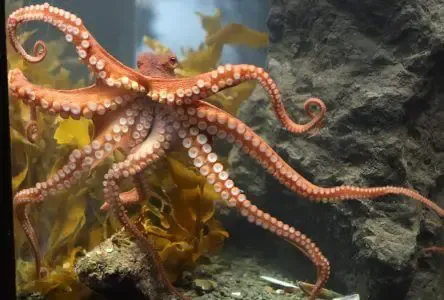We’ve heard of the tales of the 8-legged creature that roams the sea. We know how elusive that can be and how difficult they are to bring into your boat as an angler. They are some of the smartest creatures you’re likely to encounter at the bottom of the ocean and will certainly put up a fight trying to escape.
Unlike normal fishing, the best way to combat this creature is not with a stronger line, but with preparation and intelligence of your own.
Catching an octopus is a difficult task that can be quite time-consuming and frustrating for the angler. You might think you’ve got the octopus pinned and then it works its way through the tiny holes in your net. However, with the right preparation and technique, you’ll be well-prepared to combat this creative creature and bring it home for dinner.
Where to Find Octopus
The exact location of an octopus will depend on the species of octopus you’re looking for. Depending on the area you’re in, there will be different suggested environments to search in. For starters, the octopus is a saltwater species, so we can knock any ponds, lakes, or rivers off of our to do list. In terms of locating them in the ocean, this can be a difficult task as they inhabit reefs, wrecks, and surf – but also love the open ocean. The species you’re looking for will narrow your search a bit more, luckily.
Another helpful bit of information is that it’s rare that you’re going to find an octopus swimming through open waters, nowhere near the bottom. Octopus tend to be found close to objects and surfaces – reefs and wrecks are a great spot for them, but other octopuses simply love the sea floor. When you’re starting your hunt for the octopus, it’s useful to find out what local spots are popular as these will be your best bets to finding them rather than aimlessly searching for the octopus.
Once you’re in a location that is popular for octopus fishing, it’s time to search for an exact home so you can narrow the search even more. Octopuses tend to collect sea shells so when scouring the ocean floor, look for a fresh set of shells without anything growing on them yet. This will typically signal that an octopus is nearby. A helpful thing about the octopus is that their homes can be reused by other octopus so if you catch one this year, go back next year to look for more inhabitants.
How to Catch an Octopus
You’re in for a battle of the mind when trying to catch an octopus. They are smart creatures and have developed plenty of methods of escaping an angler and if you’re unprepared, you will lose that battle. Below, we have listed three of the most popular techniques for fishing an octopus. Each of these techniques have proven to be successful in different contexts.

Fishing Rods
This technique isn’t too common for octopus fishing as it can be rather difficult and might find you struggling compared to the other two options. As long as you have the proper gear, this should be doable. The first aspect you’ll want to cover is keeping your lure at the bottom of the ocean as this is where you’re most likely to come across the octopus.
The brighter the colors, the more likely you are to draw them in so use a lure that has plenty of flashy colors like reds and oranges and yellows. Once you feel a tug on your line, don’t instantly pull it back in as the octopus most likely isn’t hooked. They’re likely just holding onto the line so you want to keep it calm and let them have a few feet to play with before you reel them in.
Getting them out of the water presents a different issue as this is where the octopus is most likely to drop off. Once they’re lifted out of the water, the octopus will likely let go of the lure so be sure to have a net of some sorts to scoop them up and bring them out. The legend of the octopus being able to fit through any size hole is true so bring them in quickly, or they’ll squeeze through the net.
Pots and Traps
An octopus cannot get enough of discarded equipment at the bottom of the ocean which is why they supply their homes with plenty of shells. For an octopus, nothing is more exciting than the presence of a pot or a trap at the bottom of the ocean. They’re likely to inhabit it without the need for bait or lures at all making this the easiest method of octopus fishing.
Some anglers will boost their chances of drawing in an octopus by putting gold coins or other reflective objects in the pot to grab their attention. This is a great way of drawing in an octopus, but it could also lead to a few unwanted fish inhabiting your pot instead. Once you have an octopus living in the trap, it’s time to bring them back up to the boat.
When dropping your pots, be sure to space them out so as to cover more ground and expand your chances of catching the octopus. With an octopus pot, the yield takes much longer than a crab trap as the octopus is looking to establish this as their new home. Patience is important and it could take months before your pots are filled.
Spearing and Grabbing
One common way to catch an octopus is the classic method of spearing and grabbing. This has to be done in a more shallow area and should be done with the proper tools and protections, but is the classic method anglers have used for centuries to catch an octopus. The process is exactly as it sounds, you can use a spear to grab the octopus and then bring it into the boat with your hands.
If you’re looking for octopuses that live in deeper waters, spearing and grabbing is still a possible method but will require much more equipment to do. You’ll need to be ready to go scuba diving with your spear in hand if you’re going to catch these octopuses. The first step of this process is to coax the octopus out of it’s layer as grabbing it from inside it’s home is nearly impossible.
Once it’s out, if you’re spearing it, now’s the time to do so. However, if you’re just going to grab it and bring it in, be sure to wear protective gloves as they tend to bite in self-defence. Once the octopus is dead, be sure to protect it on the way back up to the boat as other animals will be keen to steal that away from you. Seals love octopus and will see your catch as their snack.
Best Bait to Use for an Octopus
One of your best bets for bringing in an octopus would be to use crab meat. If you’re not going to go with a live bait option, crab meat will bring the octopus to you. They cannot get enough of crab meat and if that’s the bait on the end of your rod, you’re in for a much simpler time. The one drawback of crab meat is the lack of shimmering colors to draw the attention of the octopus. However, if you’re able to get your bait close enough to the octopus, you should find success.
Any live bait would be another fantastic way to bring in an octopus. They love snacking on smaller fish and having access to the local fair would grant you a leg up on any other anglers trying to bring in an octopus. Live bait is great because it moves and acts as a normal fish would and catches the eye of your target better than lure would. You don’t have to do as much work to bring the bait to life as it already is.
If you’re going with a lure or a chum option, try to use a lure that has plenty of color and is able to reflect the available sunlight. When you’re fishing, it’s important to catch the attention of the fish and with a lure, having a shiny object will do much better than a dull one. Bring the right bait and you’ll be well-prepared to catch any octopus that you encounter.
What to Do Next
Now that you’ve got your octopus on the boat, it’s time to make sure it stays there. If the octopus is dead, that won’t be a problem, but if you brought it in alive, keep an eye on it as it will try to escape. Keep it in a container filled with water, but no way for it to escape. If there’s a hole present that you think is too small for the octopus to get out, think again.
Bringing in an octopus is a difficult task from start to finish. However, with the right tools and preparation, you’ll be able to bring one in no time.



